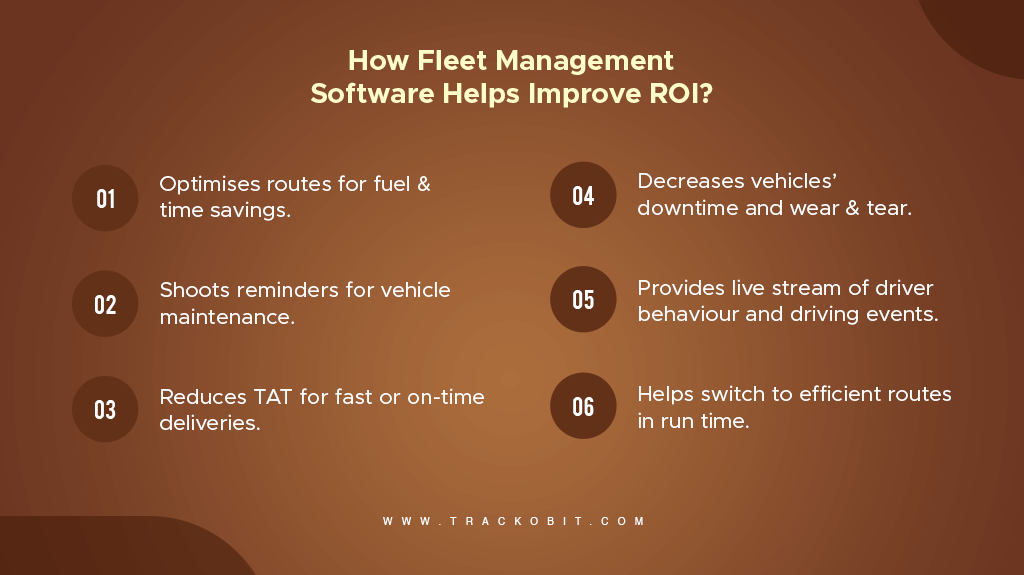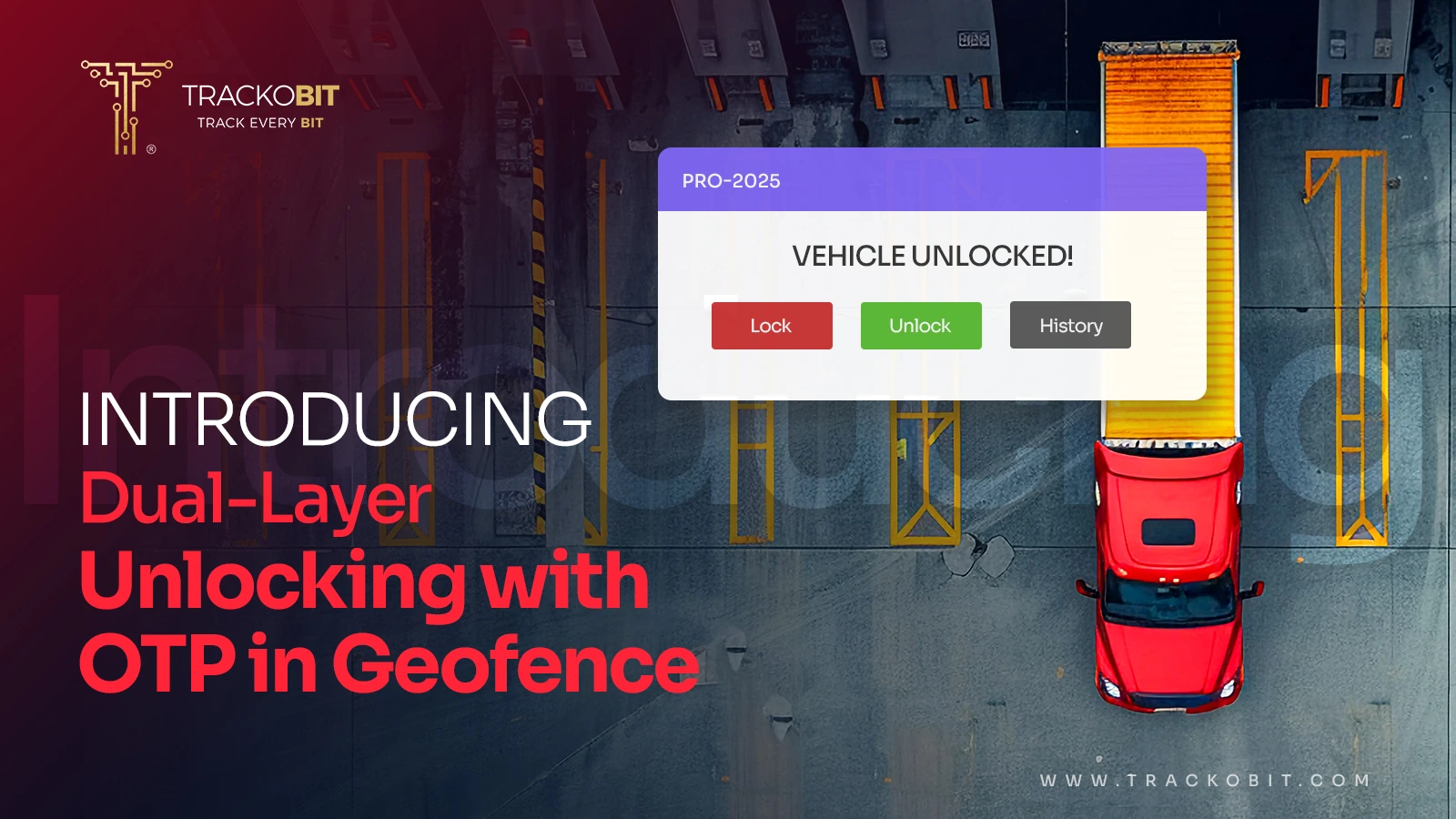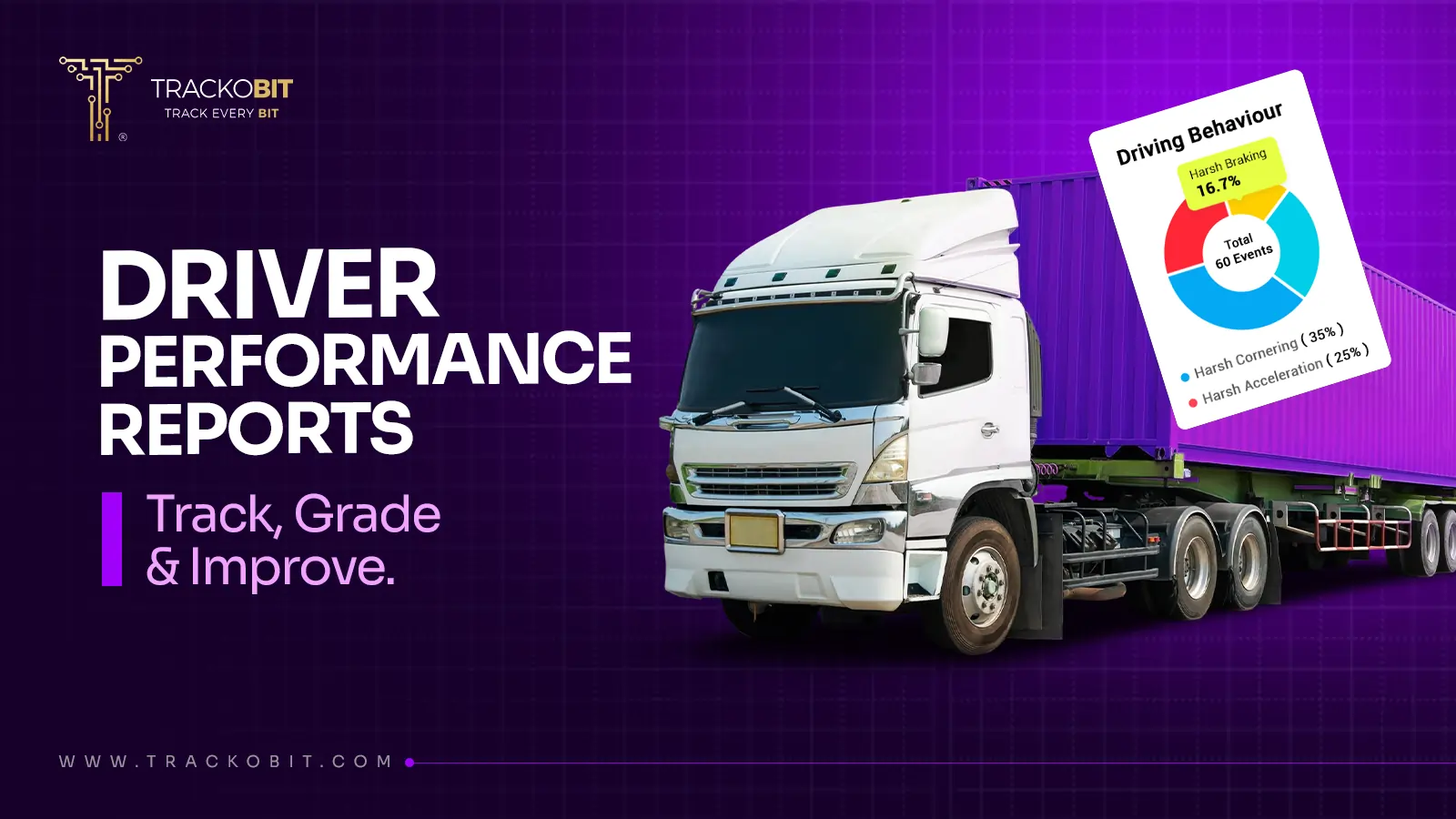-
TrackoBit
Manage commercial vehicles with the new-age Fleet Management Software
TrackoBit -
TrackoField
Streamline your scattered workforce with Field Force Management Software
TrackoField -
Features Resources
-
Blog
Carefully curated articles to update you on industrial trends. -
White Paper
Insightful papers and analysis on essential subject matters. -
Glossary
Explore an alphabetical list of relevant industry terms. -
What’s New
Get TrackoBit & TrackoField monthly updates here. -
Case Study
Explore the cases we solved with our diverse solutions. -
Infographics
Explore key topics through visually impactful infographics.
-
About Us
Get to know TrackoBit: our team, ethos, values, and vision. -
Careers
Join the most dynamic cult of coders, creatives and changemakers. -
Tech Support
Learn about our technical support team and services in detail. -
Events
Check out the exhibitions where we left our marks and conquered. -
Contact Us
Connect with us and let us know how we can be of service.
7 Smart Tactics to Improve Fleet Management ROIs – Secret to More Profits
- Author:Nandita Gupta
- Read Time:9 min
- Published:
- Last Update: September 8, 2025
Table of Contents
Toggle
Explore how investing in a fleet management system can help businesses minimise their operational costs & challenges while maximising ROI tenfolds.
Table of Contents
Toggle
Efficient fleet management is the ultimate win only if it increases ROI and customer satisfaction. And that’s possible only when you onboard advanced fleet management software. The software makes it easy to track areas where you are shelling out the most money. And allows you to take prompt actions to minimise or optimise the spending so that you can cut down costs and maximise your ROIs.
The software takes care of your complete fleet operations and lets you streamline maintenance processes, reduce travelling distances, decrease fuel consumption, and optimize driver performance.
Whether you’re a seasoned fleet manager or a business owner aiming to boost transportation efficiency, this blog will explore actionable strategies that are proven to improve fleet management ROIs.
Understanding Fleet Management ROIs
ROI in fleet management is all about tracking and evaluating the positive returns you get against the operational costs you spend to manage and monitor the fleet.
Here are the signs telling you are getting positive or maximum ROI on your operations when:
🏹 You have reduced travelling miles for the fleet by optimised routes.
🏹 Reduced fuel expenses by significant numbers.
🏹 Increased vehicle utilisation for more trips and better delivery capacity.
🏹 Lowered significant operational costs and surpassed clients’ expectations.
🏹 Reduced accidental risks and associated costs by improving driving performance.

How to Improve ROI with Fleet Management Software?
(Know Where to Hold & Limit Your Spends)
In fleet management, increased ROI is visible when the operational costs go down and the efficiency goes up the scale. Here are 8 proven ways to uplift ROIs from fleet operations without irks and risks.
1. Plan Efficient Routes & Schedules
Businesses can get the most from their assigned trips if they plan and schedule their vehicles on the shortest and most efficient routes possible. Route planning system makes it easy for fleet managers to pick the most dynamic routes for vehicles operating across multi-modal journies.
With the system, you can plan efficient routes after thoughtfully considering factors like total distance, no. of halts, delivery priorities, and more. You can even save such routes and use them on a recurring basis to fuel your efficiency. As a result, with fleet management solutions, businesses can save on fuel costs and extract huge margins.
The biggest silver lining – You are able to avoid delays, increase service time, and earn more through adjusting more delivery schedules.
Read Blog – Why route planning is important in logistics?
2. Make Optimum Use of Your Fleet
Get hold of how optimally each asset or vehicle in the fleet is utilised. Know which vehicle is overutilized, underutilised, and marginally utilised. When you use GPS vehicle tracking software, you get a holistic view of each vehicle over a dashboard detailing about:
- Total number of available vehicles
- Vehicles that are actively running, inactive, overspeeding, idling, or unreachable
- Vehicles that are idling with a complete time duration
Also, with the fleet tracking solution you can calculate the total mileage each vehicle has covered, which helps balance such vehicle’s utilisation and capacity. This way you are able to reduce travelling miles and prevent vehicle wear and tear — which results in adding more to your ROI.
3. Keep an Eye on Fuel Consumption
Fuel accounts for 60% of the operating costs for fleet businesses. Reducing fuel consumption can help cut down spending and make room for more earnings. To cut down unnecessary fuel consumption, it’s important to analyse your current fuel consumption patterns.
By leveraging TrackoBit’s vehicle telematics software, you can get comprehensive reports on:
—> How much fuel every vehicle in the fleet is consuming?
—-> You can extract the trends of harsh acceleration, overspeeding, and idling in events other than traffic signals.
—-> Routes that are long. And are unnecessarily adding to extra miles and more fuel bills.
Keeping tabs on your fleet activities and fuel consumption trends can help optimise routes and reduce the chances of risky events. Thus, eventually helping you improve fleet ROI.
4. Reduce Frequent Maintenance Costs
Make sure you schedule timely preventive maintenance services based on vehicle usage. A regular maintenance schedule lets you minimize downtime and prevents costly repairs. As a result, you can increase the vehicle’s uptime, perform more deliveries, and earn more new revenue.
By having a fleet management system, you can:
- Set reminders to schedule vehicles’ timely maintenance.
- Generate insightful reports summarising the vehicle’s health.
- Track events of vehicle repairs.
- Identify total fleet maintenance and management costs and compare them to budgets for better cost control.
5. Ensure Enhanced Driver Performance
Invest in driver behaviour monitoring solutions to have a hold on your driver’s driving events. The software helps you recognise the driving events that are putting pressure on the engine and causing it to stall or consume more fuel. The system sends up-to-the-minute reports about harsh acceleration, braking, and abrupt speeding and helps differentiate between a good and a bad driver.
Moreover, when you club a driver management system, you can even track how efficiently and attentively your driver is driving the fleet. The system requires you to install an AI-enabled dashcam with which you can monitor your drivers’ live actions and get alerted whenever he:
- Leaves the cabin for too long
- Yawns or appears to be drowsy
- Lights cigarettes or do freewheeling
- Has poor conduct while driving – is jumping the red lights or violating traffic rules
With the above two systems, you can generate a wealth of visual and textual data to investigate events that contribute to hefty fuel and maintenance costs.
| Further, based on the collected data…
You can set up comprehensive driver training programs to teach fleet operators or drivers about:
Having an improved driver performance will help reduce the risk of accidents, lowering insurance premiums and maintenance costs while positively uplifting ROI. |
6. Maximise Drivers’ Potential
Other than keeping a hawk eye view on how attentively your driver is driving the fleet, know how efficiently he completes the assigned trip. Or how many trips or successful deliveries he achieves. All centrally via fleet management solutions.
Measuring the efficiency and productivity of drivers will help you know how well they are adding to your new revenue. Set KPIs to evaluate:
- Total distance travelled by an individual driver. Was it less or equal to the defined hours of service (HOS)?
- Frequency of stops or halts. Were the pit stops too lengthy and too many?
- Total trips per driver. Was it less than what was assigned?
- Ratio of successful and on-time deliveries. Was there a delay in the arrival of consignments or did your drivers fail to fetch a positive happiness code from the recipient?
TrackoBit’s vehicle monitoring software comes with an analytical dashboard wherein you can evaluate the above data carefully and know which driver is adding to your revenue streams.
Read Blog – What is a Driver Scorecard? Why is it Important?
7. Timely Compile TCO (Total Cost of Ownership)
| 🔎 Return of Investment (ROI) > Total Cost of Ownership (TCO) |
Your fleet’s ROI grows well when you can minimise its total costs of ownership. As a fleet manager, you must calculate all the costs you bear other than purchasing or financing the vehicles. Compile…
- Vehicle’s Maintenance spends
- Total Fuel costs
- Spending on insurance premiums
- Drivers’ wages or any miscellaneous expenses bored during fleet operations
Tracking ROI in the fleet management process is not enough. You have to come up with strategies that can help reduce your total costs to win some major returns.
How to Measure ROI for Your Fleet Operations?
Once you have identified and calculated all the investments you made against fleet operations, use this formula to calculate ROI.

In the above…
- Net Benefit = Total savings resulting from the benefits like reduced fuel costs, maintenance expenses, etc.) minus the total operational costs you invested.
- Total Investment = Initial expenditure or investment plus any recurring operating expenses like fuel costs, maintenance costs, wages, etc.
6 Tips to Keep in Mind While Measuring ROI for Fleet-Related Investments
Measuring return on investment (ROI) for fleet-related investments with the fleet management system helps you assess the effectiveness and profitability of total investments being made. Here are some other tips to move your investments towards better earnings.
1. Identify Investment Objectives
Have well-defined objectives for your fleet-related investment. It is to:
👏 Reduce maintenance and fuel costs
👏 Enhanced driver’s efficiency and safety
👏 Increase asset utilization
Having clear objectives from day one will help you take ROI measurement efforts in the right direction.
2. Establish Key Performance Indicators (KPIs)
Identify metrics that are helpful in measuring the success of your investment. You can set some metrics around:
- Fuel consumption rates
- Maintenance costs per mile
- Vehicle utilization, downtime, and accident rates
- Drivers’ efficiency and productivity in trip completion
- Successful delivery times with POD and happiness codes
3. Measure Performance Improvement
After making the required investments, make sure to track the improvement in the established KPIs. From time to time, compare before-and-after data to ascertain that investments are going in the right direction.
4. Consider Timeframe
Pre-plan the timeframe or occasions you will measure your ROI. Will it be monthly or quarterly or specifically after completing the peak season?
Note that not all investments will yield immediate benefits, some may take longer to generate returns. Make sure you plan the timeframe while considering both the short-term and long-term impact of each variable.
5. Look for Intangible Variables
Improved customer satisfaction, enhanced brand reputation, and goodwill are a few intangible variables that may be hard to quantify and assess. But you can measure them through other areas, maybe through your:
- Drivers’ productivity and efficiency
- Efficient fleet utilisation and allocation
- Successful accounting of POD and happiness codes
6. Regularly Review and Optimise
Make sure to consistently monitor fleet performance and ROI over time. Keep reviewing KPI to identify areas for improvement and work towards effective fleet management strategies that could increase ROI.
Final Takeaway!
With the above steps, fleet managers can measure their operational expenses and optimise them to increase the ROI/investment. In the end, gauging the above data will also help enhance efficiency throughout the lifecycle of fleet management and make level-headed operational decisions.
Looks like it’s hard to avoid the benefits associated with investing in a fleet management solution. From keeping track of every spend to helping identify gaps where productivity is lacking — it gives you much-needed clarity. When you choose a well-designed fleet monitoring solution from the house of TrackoBit, you say yes to:
- Ensuring effective utilisation of every vehicle.
- Ensure driving events that reduce maintenance spending.
- Travel shorter and more efficient routes that lead to fuel economy.
- Review driver behaviour and productivity that leads to safe and economical driving events.
All in all, you get the best of everything that fills your pocket with new revenues and profit margins. Also, get to ensure superior service for your customers.

Nandita is the Team Lead for Content Marketing at TrackoBit, bringing over a decade of experience in B2B, B2C, and IoT sectors. She has a proven track record of helping Read More
Related Blogs
-

How to Use Driver Behavior Reports as a Sales Hook to Close Big Fleets
Tithi Agarwal October 16, 2025TrackoBit’s driver behavior reports empower fleet providers to win big contracts by showcasing safety, efficiency, and measurable ROI.
-

TrackoBit’s Unlocking in Geofence with OTP: Elevating Cargo Protection
Tithi Agarwal September 16, 2025TrackoBit’s latest feature – Unlocking in Geofence with OTP lets you lock out theft and unlock cargo only at the…
-

The Rise of Electric Fleets: Challenges and Opportunities for Businesses
Tithi Agarwal September 4, 2025The global fleet landscape is poised for a decade-long transformation. This change is being powered by electricity. Logistics-led businesses are…
-

Who’s Really Behind the Wheel? Unlocking Insights with Driver Performance Reports
Tithi Agarwal August 27, 2025Identify top-performing drivers, monitor violations, and grade skills with the driver performance report. This makes fleet operations more transparent and…

Subscribe for weekly tips to optimize your fleet’s potential!
Your inbox awaits a welcome email. Stay tuned for the latest blog updates & expert insights.
"While you're here, dive into some more reads or grab quick bites from our social platforms!"Stay Updated on tech, telematics and mobility. Don't miss out on the latest in the industry.
We use cookies to enhance and personalize your browsing experience. By continuing to use our website, you agree to our Privacy Policy.

































